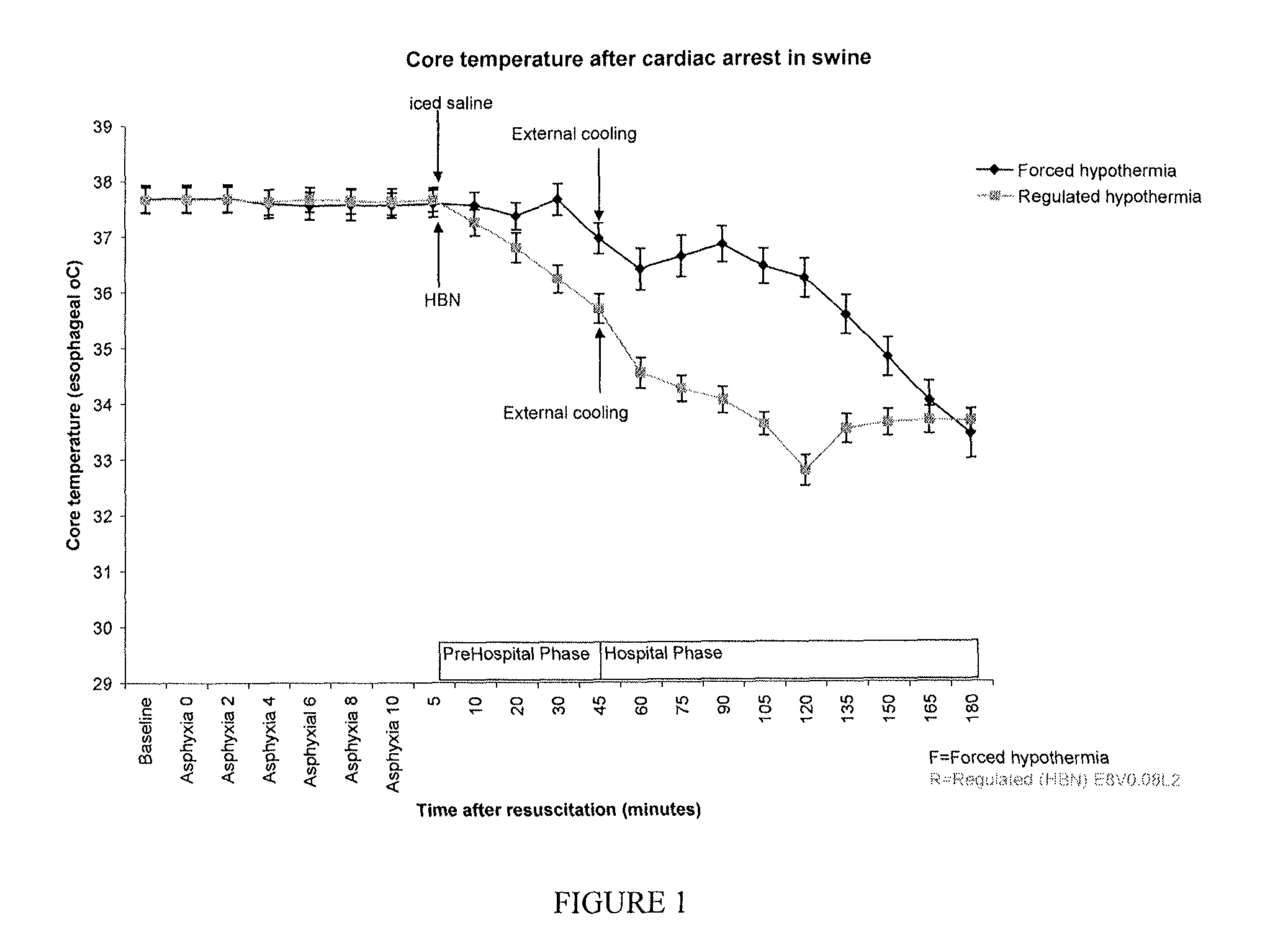Methods and compositions for the induction of hypothermia
a technology of induction and hypothermia, applied in the field of therapeutic hypothermia, can solve the problems of undesirable thermo-effector responses, and achieve the effect of reducing the time necessary
- Summary
- Abstract
- Description
- Claims
- Application Information
AI Technical Summary
Benefits of technology
Problems solved by technology
Method used
Image
Examples
examples 1 and 2
Methods for Examples 1 and 2
[0224]Rat Model of Asphyxial Cardiac Arrest:
[0225]The outcome model of asphyxial cardiac arrest in rats was used for these studies and has been described previously (Katz et al. (1995) J Cereb Blood Flow Metab 15:1032-1039). Briefly, rats were anesthetized with 4% isoflurane, intubated and mechanically ventilated, anesthesia was titrated and vessel catheters inserted. Cardiac arrest was induced by apneic asphyxia with chemical paralysis (vecuronium 2 mg / kg) and discontinuation of ventilation. After 10 minutes of asphyxial cardiac arrest, rats were resuscitated with mechanical ventilation, 100% O2, epinephrine (0.005 mg / kg) and chest compressions. Rats were extubated two hours after resuscitation and placed in a humidity and temperature controlled incubator. Rats were sacrificed by an overdose (5%) of inhaled isoflurane and then perfusion fixed with 100 ml of 4% paraformaldehyde at a perfusion pressure of 100 mmHg. Multiple coronal sections (10 μm thicknes...
example 1
Administration of Ethanol-Comprising Multidrug Combinations Provide Partial to Complete Neuroprotection in a Rat Model of Cardiac Arrest
[0239]Asphyxial cardiac arrest was used as the acute insult in these studies as this type of cardiac arrest may benefit most from regulated hypothermia because the therapeutic window is narrow, as demonstrated in pilot experiments. Rats underwent ten minutes of asphyxial cardiac arrest and resuscitation. Five minutes after the return of spontaneous circulation (ROSC), rats were administered 15 ml / kg of iced normal (0.9%) saline (5° C.) (forced hypothermia) or half of the indicated treatment (at room temperature, 21° C.) intravenously over 20 minutes. The first infusion was followed immediately by a second 20-minutee infusion (15 ml / kg) with iced saline (5° C.) for the forced hypothermia group or the second half of the indicated treatment (at 21° C.).
[0240]When the second infusion was completed (45 minutes after ROSC), the forced hypothermia rats wer...
example 2
Effects of Various Ethanol-Comprising Multidrug Combinations on Survival and Neurological Deficits in the Rat Model of Asphyxial Cardiac Arrest
[0247]The rat outcome model of asphyxial cardiac arrest was used to test each of the components of the cocktail to determine the effects of the components on NDS and performance in the Morris Water Maze. Rats undergoing forced hypothermia and rats maintained under normothermic conditions (with 0.5 U / kg vasopressin administered) served as controls. Raw survival and NDS data is shown in Table 1 and Table 2 provides a summary of the survival and NDS data.
[0248]Administration of ethanol alone (under normothermic conditions) at doses of 1 g / kg, 1.5 g / kg, and 2 g / kg were able to enhance survival of the rats about 1.5- to 3-fold and reduced the neurological deficit score at 72 hours after resuscitation. Vasopressin alone (under normothermic conditions) also enhanced survival approximately 3-fold and reduced neurological deficits 72 hours after resus...
PUM
| Property | Measurement | Unit |
|---|---|---|
| concentration | aaaaa | aaaaa |
| concentration | aaaaa | aaaaa |
| core body temperature | aaaaa | aaaaa |
Abstract
Description
Claims
Application Information
 Login to View More
Login to View More - R&D
- Intellectual Property
- Life Sciences
- Materials
- Tech Scout
- Unparalleled Data Quality
- Higher Quality Content
- 60% Fewer Hallucinations
Browse by: Latest US Patents, China's latest patents, Technical Efficacy Thesaurus, Application Domain, Technology Topic, Popular Technical Reports.
© 2025 PatSnap. All rights reserved.Legal|Privacy policy|Modern Slavery Act Transparency Statement|Sitemap|About US| Contact US: help@patsnap.com

